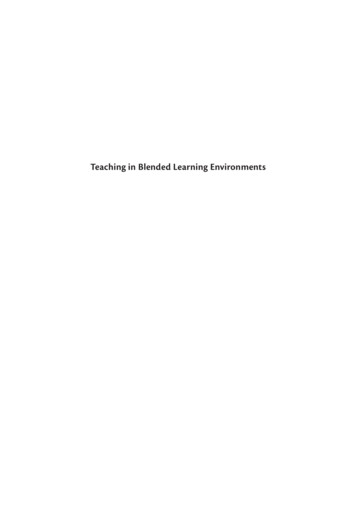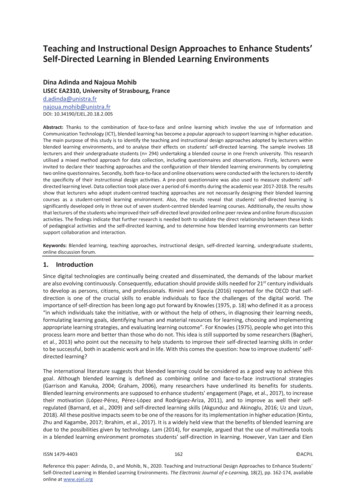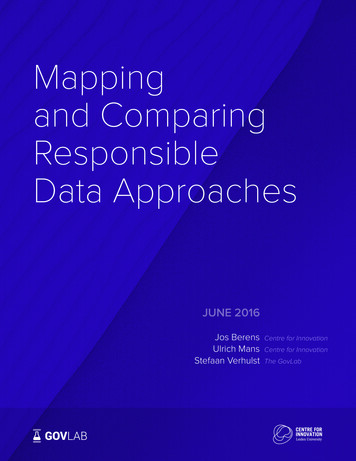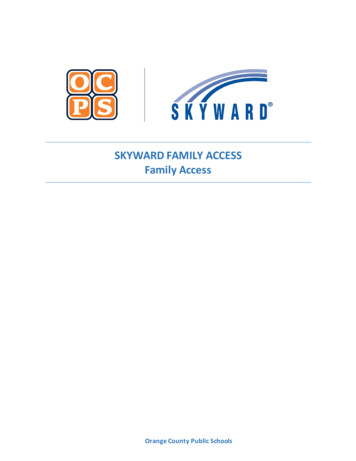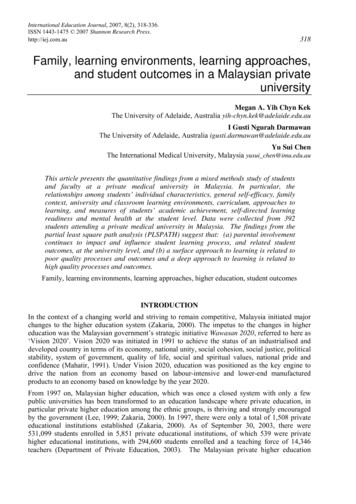
Transcription
International Education Journal, 2007, 8(2), 318-336.ISSN 1443-1475 2007 Shannon Research Press.http://iej.com.au318Family, learning environments, learning approaches,and student outcomes in a Malaysian privateuniversityMegan A. Yih Chyn KekThe University of Adelaide, Australia yih-chyn.kek@adelaide.edu.auI Gusti Ngurah DarmawanThe University of Adelaide, Australia igusti.darmawan@adelaide.edu.auYu Sui ChenThe International Medical University, Malaysia yusui chen@imu.edu.auThis article presents the quantitative findings from a mixed methods study of studentsand faculty at a private medical university in Malaysia. In particular, therelationships among students’ individual characteristics, general self-efficacy, familycontext, university and classroom learning environments, curriculum, approaches tolearning, and measures of students’ academic achievement, self-directed learningreadiness and mental health at the student level. Data were collected from 392students attending a private medical university in Malaysia. The findings from thepartial least square path analysis (PLSPATH) suggest that: (a) parental involvementcontinues to impact and influence student learning process, and related studentoutcomes, at the university level, and (b) a surface approach to learning is related topoor quality processes and outcomes and a deep approach to learning is related tohigh quality processes and outcomes.Family, learning environments, learning approaches, higher education, student outcomesINTRODUCTIONIn the context of a changing world and striving to remain competitive, Malaysia initiated majorchanges to the higher education system (Zakaria, 2000). The impetus to the changes in highereducation was the Malaysian government’s strategic initiative Wawasan 2020, referred to here as‘Vision 2020’. Vision 2020 was initiated in 1991 to achieve the status of an industrialised anddeveloped country in terms of its economy, national unity, social cohesion, social justice, politicalstability, system of government, quality of life, social and spiritual values, national pride andconfidence (Mahatir, 1991). Under Vision 2020, education was positioned as the key engine todrive the nation from an economy based on labour-intensive and lower-end manufacturedproducts to an economy based on knowledge by the year 2020.From 1997 on, Malaysian higher education, which was once a closed system with only a fewpublic universities has been transformed to an education landscape where private education, inparticular private higher education among the ethnic groups, is thriving and strongly encouragedby the government (Lee, 1999; Zakaria, 2000). In 1997, there were only a total of 1,508 privateeducational institutions established (Zakaria, 2000). As of September 30, 2003, there were531,099 students enrolled in 5,851 private educational institutions, of which 539 were privatehigher educational institutions, with 294,600 students enrolled and a teaching force of 14,346teachers (Department of Private Education, 2003). The Malaysian private higher education
Kek, Darmawan and Chen319enterprise is set to grow further, as it aims to be a centre of educational excellence in the region(Lee, 1999; Rao, 1997).However, these private higher educational institutions are perceived by the public at large asbeing ‘for-revenue’ or ‘profit’ institutions, in that the private sector tends mainly to offerprograms that have high private benefits (profits) but fewer social benefits (Wilkinson & Yussof,2005). This perception gives rise to another related public perception that ‘poor qualityeducation’ is being provided by the private higher educational institutions compared to thoseprovided by the public universities (Wilkinson & Yussof, 2005). This related perception may befurther entrenched in the minds of the public at large due to the early years after independence in1957, where the private sector education in Malaysia had merely catered for so-called ‘dropouts’or provided language and religious education for minority groups (Wilkinson & Yussof, 2005).In order to ensure quality education, all private higher educational institutions, in addition tohaving to register with and be approved by the Ministry of Education, must abide by theParliament Acts such as the Private Higher Educational Institutional Act 1996 and the EducationAct 1996. In addition, the government of Malaysia established the National Accreditation Board(NAB) regulated under The National Accreditation Board Act 1996, as a national qualityassurance agency responsible for governing the standard and quality of courses offered by theprivate higher educational institutions. These measures assist to reduce the negative perceptionsthat the quality of teaching and learning in private higher education is inferior and comprised ofinferior learning contexts for dropouts.While it is clear that private higher education will remain as a permanent feature in the Malaysianeducation landscape under the auspices of Vision 2020, if private higher education is to gaingreater status and standing in society, there is a critical need to consider and understand thelearning environments that can foster the aims of the nation. What then are the contextual factorsof a learning environment that can enhance students’ learning, in particular, how they approachtheir learning in a meaningful way? In particular, what are the learning environments that mayinfluence related outcomes such as the intellectual capacity, well-being, and lifelong learningcapacity of a student? Lastly, how do the learning environments influence student learning andoutcomes?THEORETICAL MODEL FOR ANALYSISThe study discussed in this paper was guided by Kek’s (2006) proposed two-level theoreticalframework which examined the student and teacher ecological systems and their influences onstudent learning and outcomes in higher education. The framework integrated constructs fromthree different but complementary fields of learning environments, approaches to learning andapproaches to teaching. The theoretical base was drawn from the theories and theoreticalframeworks of Bronfenbrenner’s (1979) Ecological Theory of Human Development,Bronfenbrenner and Ceci’s Bio-Ecological Model of Human Development (Bronfenbrenner &Ceci, 1994), Biggs’ 3 P Model of Learning (2003), and Prosser, Ramsden, Trigwell and Martin’sModel of Teaching (2003).For the purpose of this paper, only the student level of the proposed two-level theoreticalframework, depicted in Figure 1 is discussed. See Kek (2006) for full details of the theoreticalbase and theoretical framework.Student Ecological LevelBronfenbrenner’s Human Development and Bio-Ecological (1979; 1994), and Biggs’ 3 P (2003)concepts are applied to depict the interconnections between students’ individual characteristics,the distal or more remote and proximal or immediate contextual factors (presage), approaches tolearning (process) and outcomes (products) in higher education at the students’ interrelatedecological level.
320Family, learning environments, learning approaches, and student outcomesPresagePersonal, Distal & Proximal ContextsSTUDENTECOLOGICALLEVELFamilyParents’ aspirations,Parental involvement,Parents’ acyStudentOutcomesLearning ApproachesDeep ApproachSurface entSelf-directedLearningMental oom-levellearning environmentSource: Applied from Bronfenbrenner’s Theory of Human Development (1979) and Bronfenbrenner & Ceci’s Bio-EcologicalModel of Human Development (1994), Adapted from Biggs’ 3P Model of Learning (2003, p. 19)Figure 1. Theoretical model for analysis – Student levelThe theoretical model proposes that the proximal contexts are composed of the immediatelearning contexts where teaching and learning occurs. The proximal contexts are the curriculum(perceptions of the curriculum alignment) and classroom-level learning environment (perceptionsof the classroom-level learning environment). The distal contexts are the family context (parents’aspirations, parents’ educational attainment and parental involvement), self-efficacy (general selfefficacy beliefs), and university-level learning environment (perceptions of the university-levellearning environment). The distal and proximal contexts, in addition to the individualcharacteristics (gender and ethnicity) form the proposed presage factors.The proposed presage factors are also conceptually placed in an orderly sequence. The placementstarts with the individual characteristics, and the rest of the presage factors are sequenced fromthe distal contexts, moving into the proximal contexts. Hence, the sequence of the proposedpresage factors is: (a) individual characteristics; (b) family context; (c) self-efficacy; (d)university-level learning environment; (e) curriculum; and (f) classroom-level learningenvironment.The proposed presage factors are related to the hypothesised process of students’ approaches tolearning (a deep or surface approach to learning), which in turn are related to the products.Approach to learning refers to the processes adopted during learning, which directly determinethe outcome of learning and predisposition to adopt particular processes (Biggs, 2001). Broadly,the two ways of relating to learning have become known as surface and deep learning approachesto learning. According to Biggs (2001), a surface learning approach focused on the extrinsic orexternal motivation, and used strategies that consumed the least amounts of time and effort tomeet the requirements. In contrast, a deep approach to learning in general focused on the intentionthat was intrinsic in nature or the intention to comprehend, and adopted strategies to maximiseconceptual understanding.The products proposed for this research study are the students’ academic achievement, selfdirected learning readiness, and mental health outcomes.Hypothesised Relationships and InfluencesIn this paper, the relationships among the contextual factors, student learning and a set of studentoutcomes (academic achievement, self-directed learning readiness, and mental health) at thestudent level were examined. It is hypothesised that there are direct and mediated relationships
Kek, Darmawan and Chen321between the students’ individual characteristics, distal contexts (family, self-efficacy, universitylevel learning environment), proximal contexts (curriculum and classroom-level learningenvironment), learning approaches and academic achievement, self-directed learning, and mentalhealth.METHODThe data in this paper were collected from a study that focused on the student and teacherecological systems and their influences on student learning and outcomes in a private medicaluniversity in Malaysia.DataEvidence for this paper was derived from questionnaires administered to 475 pre-clinicalstudents, representing three study levels from the International Medical University, Malaysia(IMU) in 2004.The IMU started as the International Medical College, the first and only private medical collegein the Asia Pacific region in 1992, had university status conferred in 1999, and has over 25prestigious Partner Medical Schools (PMS) worldwide (International Medical University, 2005).Like many private universities in Malaysia, its students are drawn predominantly from theChinese ethnic group1. The medical program in Malaysia constitutes the pre-clinical phase wherestudents have to undertake five semesters or 2.5 years of coursework. During the pre-clinicalphase, the students learn basic medical sciences, clinical and communication skills, and aspects ofmedicine applicable to Malaysia. Upon successful completion of the foundation medical sciences,the students complete their medical degrees through clinical studies for another four to sixsemesters. Students can either complete their clinical studies in Malaysia at one of two IMUclinical schools at Batu Pahat or Seremban for a period of five semesters, and graduate with aMBBS from the IMU, or attend one of the 25 PMS for a period of four to six semesters, andgraduate with the medical degree of the selected PMS overseas.At the IMU, problem-based learning (PBL) was employed in the classrooms. PBL was the maincurriculum delivery tool where teachers facilitated student learning in small groups to encourageteamwork, to solve problems, to learn and integrate knowledge acquired using simulated clinicalproblems, to do self-directed learning and become life-long learners (International MedicalUniversity, 2005). Each student at the IMU had to attend small group PBL sessions with ateacher, commonly known as the PBL tutor or facilitator, twice a week for a period of one and ahalf hours each session. In the PBL sessions or classrooms, the students learnt about medicalsciences, and integrated the knowledge acquired through simulated clinical problems, known asthe “PBL triggers” (International Medical University, 2005).The final sample was: 179 students from 17 PBL classrooms in study level 1/ semester 1; 173students from 16 PBL classrooms in study level 2/ semester 4; and 123 students from 11 PBLclassrooms in study level 3/ semester 5. A 82.5 per cent response rate was obtained, withquestionnaires received from a total of 392 students: 165 students in study level 1/ semester 1;140 students in study level 2/ semester 4; and 87 students in study level 3/ semester 5. Theresponse rates for semesters 1, 4 and 5 were 92.2 per cent, 80.9 per cent, and 70.7 per cent,respectively. From the final student sample, 43.4 per cent was male, and 56.6 per cent wasfemale. The ethnic composition of the sample was 72.2 per cent Chinese, 15.8 per cent Malay,10.7 per cent Indian, and 1.3 per cent Others. The average age of the students was 20.3 years old.1Malaysia is a plural society. The 2000 Census reports the population of Malaysia to be 23.27 million and with anethnic composition of 65.1% Bumiputera*, 26% Chinese, 7.7% Indian, and 1.2% Others (which include Eurasians,Sri Lankans and other communities) (Department of Statistics, 2000). *Bumiputera means “native of the soil”. Thisterm is used to include the Malays and other indigenous tribes such as the Ibans in Sarawak and the Kadazan Dusunand Bajau in Sabah.
322Family, learning environments, learning approaches, and student outcomesPartial Least Path Analysis (PLSPATH)The aim in using path analysis was to surpass correlation as mere association but to directanalyses towards the examination and confirmation of specified causal relationships betweenvariables. Keeves (1988, p.724) suggested that the use of path analysis made it possible foreducational researchers “to shift from verbal statements of a complex set of interrelationshipsbetween variables to more precise mathematical ones and to estimate the magnitude of the causallinks involved.” In this study, the purpose was to identify the pattern of relationships betweenstudents’ individual characteristics (gender and ethnicity), parents’ educational attainment,parents’ aspirations, parental involvement, general self-efficacy, university-level learningenvironment, curriculum, classroom-level learning environment, learning approaches (deep andsurface learning approaches), and academic achievement, mental health, and self-directedlearning readiness outcomes.The PLSPATH program was selected for this study because the technique has proved to beflexible and robust in testing complex models, did not require rigorous distributional assumptionsof variables, accepted categorical and dichotomous variables, and recognised the use of complexcluster sample designs in data as is the case with this study (Sellin & Keeves, 1997). In addition,the PLSPATH program was appropriate for investigating complex models in an exploratoryrather than a confirmatory fashion (Sellin, 1995, p.256). Although the approach is flexible, Sellinand Keeves (1997) argue that the PLSPATH program should not be seen to be exploratory andlacking in rigour because the PLSPATH program demands the development of a well-specifiedmodel for examination and estimation.Therefore, the PLSPATH program was used to examine and estimate the direct and mediatedrelationships of the individual characteristics, family context, general self-efficacy, university andclassroom learning environments, curriculum, learning approaches and outcomes at the studentlevel. Separate analyses were also conducted for each study level in order to examine theconstancy of measures across study levels through the use of replication (Sellin & Keeves, 1997,p.634). In this way, a further examination of development across study levels was enabled.However, for this paper, only the final path result of the total student sample (n 392) is presentedand discussed.Methodological IssuesThe PLSPATH program is based on the partial least squares procedure (PLS) introduced by Wold(1985) as a method to maximise prediction and explanation of path models. The PLS procedure isconceptually related to principal component analysis, canonical correlation analysis, andregression analysis. According to Sellin (1995, p. 266), the PLS procedure is a “flexible andextremely powerful technique for the examination of path models with latent constructs measuredby multiple indicators.”A PLSPATH model is formally defined by two sets of linear equations, termed the inner modeland the outer model (Sellin, 1995). The inner model refers to the relationships betweenunobserved or latent variables (LVs). The outer model refers to the relationships between LVsand their associated observed or manifest variables (MVs).There are two types of relationships between LVs and their associated MVs (Edwards & Bagozzi,2000; Sellin & Keeves, 1997). The first type is where the constructs (LVs) are viewed as thecauses of measures and they are referred to as ‘reflective’ or manifestations of a construct. Thatis, variation in a construct (LV) leads to variation in its measures. Arrows are drawn from the LVto MVs or known as the outward mode arrows to indicate this type of reflective relationships. Thesecond type is where the measures are viewed as causes of constructs and they are referred to as‘formative’. That is, the construct is formed from the measures. Arrows are drawn from the MVsto the LV or known as the inward mode arrows to depict this type of formative relationships.
Kek, Darmawan and Chen323A number of indices are used to determine the strength of the relationships between the MVs andLVs. The most common indicator of the relationship is the loading, with other indices such asweight also being used (Sellin, 1989). To be effective, loadings should be reported where theoutward mode is used, and weights should be reported where the inward mode is used (Sellin &Keeves, 1997).The PLS procedure works by calculating an estimate for each LV, which is obtained from thecorresponding MVs, thus, partitioning the hypothesised inner model into its componentconstructs. The PLSPATH program is iteratively processed until all the estimates are found to bestable. In this way, the relationships between LVs in the path model or the inner model signify thecausal relationships between the LVs. The causal relationships are indicated by unidirectionalarrows from the determining variables to the dependent variable, whereas determining variableswhich do not depend on any other variables are referred to as exogenous variables and are notindicated by any unidirectional arrows pointing toward the variable (Tuijnman & Keeves, 1997).Data PreparationPrior to modelling with the PLSPATH Version 3.01 program, data screening was undertaken toidentify variables for missing data in excess of 20 percent (Keeves, 1997), so that these variablesare omitted for effective analyses. The missing data are recommended to be replaced by assigningmeans (Sellin, 1989, p. 47). In this study, there were 12 cases or 3.8 percent missing data from theacademic achievement variable, which were subsequently replaced with the mean.The next step was evaluating the direction of the relationships of the MVs and LVs by examiningeither the factor loadings or correlations between the variables. The examination of the factorloadings, shown in Table 1 indicated that the directions between MVs and LVs used in the studywere in the outward mode, with the exception of the university-level learning environment, whichwas in an inward mode due to the low correlation coefficients.Table 1. Directions of relationships between MVs and LVsLatent Variable (LV)Manifest Variable (MV)Family capitalMothers’ involvementFathers’ involvementParent aspiration for programParent aspiration for educationSense of membershipPeer supportDeep motiveDeep strategySurface motiveSurface strategyPersonal relevanceUncertaintyCritical voiceShared controlStudent negotiationParent aspirationsUniversity-level learningenvironmentDeep approach tolearningSurface approach elation(r)FactorLoading0.67**DirectionbetweenMV and ard0.72**0.660.380.800.750.67Outward* p 0.05, ** p 0.01Model Building, Refinement and EvaluationFalk (1987) suggested that the best way to start model building using the PLSPATH was bydrawing a path diagram of the data analysis to be undertaken. All LVs and their associated MVswere defined in the input file in such a manner that they were all systematically ordered.In refining the model, two approaches were used. The first approach was to use the jackknifingmethod (Sellin, 1989). This method examines the effects that elimination of a variable has on themodel parameter estimates. Sellin (1989) suggested that a path coefficient (betas) of 0.07 or
324Family, learning environments, learning approaches, and student outcomesgreater was considered to be significant in large samples or 0.10 for small samples. Darmawan(2003) further recommended that the path coefficient (betas), and corresponding weight andloading to exceed twice the corresponding jackknife estimate of the standard error at a 95 per centconfidence interval. For noteworthy paths, the path coefficient, and corresponding weight andloadings may be above 1.68 jackknife estimate of the standard error at a 90 per cent confidenceinterval.The second approach was the use of minimal values for loading, weight and path coefficientproposed by Sellin and Keeves (1997). For the outer model, a weight of 0.10 is the minimumvalue for inward mode, and a loading of 0.30 is the minimum value for outward mode. For theinner model, a path coefficient minimum value of 0.05 to 0.10 is acceptable. In this manner, pathswith a loading, weight and path coefficient smaller than the minimal values were removed fromthe model and only those paths were retained which contributed substantially to explaining adependent LV.In addition to examining point estimates such as loadings, weights, and inner model coefficients,fit indices were also used to indicate the predictive power for model evaluation. The indicatorsobtained from PLSPATH analysis, namely R2 and jackknife standard error estimates arecommonly used (Sellin & Keeves, 1997). The R2 value represents the amount of varianceexplained in each endogeneous LV. It indicates the predictive strength of the inner modelrelationships. Jackknife estimates of standard errors provided in brackets in all the paths, togetherwith the loadings, is indicative that all the estimates are substantial when considering thejackknife rule of thumb for refining models.In order to evaluate the noteworthiness of specific LVs, the factor loadings (l) of the MVs, whichreflect the specific LVs, can be examined. The size of the factor loading provides an indication ofthe relative contributions of the different MVs.The key consideration guiding the development and refinement of the model is parsimony. In thiscontext, parsimony refers to the creation of a model that is meaningful and well-fitting, and thatcontributes to prediction and explanation of variance (Sellin & Keeves, 1997).Hypothesised Path ModelFigure 2 presents the hypothesised model derived from the theoretical model for analysis. InFigure 2, the MVs and LVs used in the model are also indicated, with MVs represented withsmall rectangular boxes, while the rounded rectangular boxes represented the LVs or constructsderived from the MVs. A summary of the MVs and LVs used is provided in Table 2.The inner model depicted in Figure 2 represented the hypothesised relationships between the LVs,in a way that LVs at the left-hand side of the model influenced LVs assigned to the right-handside in the path. Conversely, the LVs at the far most left (antecedent variables) were notinfluenced by LVs to the right of the path model. The criterion variables (outcomes) were placedon the furthest right.From the theoretical model, it was proposed that the presage factors are the students’ individualcharacteristics (gender and ethnicity), distal contexts of family (parents’ educational attainment orhuman capital, parents’ aspirations and parental involvement or family capital), self-efficacy(general self-efficacy), university-level learning environment (sense of membership in theuniversity community and sense of peer support), and the proximal contexts of classroom-levellearning environment (personal relevance, uncertainty, critical voice, shared control, and studentnegotiation) and curriculum (curriculum alignment).The proposed presage factors are related to the hypothesised process of students’ approaches tolearning, which in turn are related to the products. The products proposed for this research studyare the students’ academic achievement, self-directed learning readiness, and mental healthoutcomes.
Kek, Darmawan and lrgsescaligndmdsFigure 2. Hypothesised path model of individual characteristics, family context, general selfefficacy, university, classroom, learning approaches and outcomesFor the path analyses, gender and ethnicity are hypothesised as exogenous variables orantecedents, as they are not influenced by other LVs. The remaining presage factors and processare viewed as endogenous because they mediate the effects, or are influenced by other LVs.The criterion variables are the product factors: academic achievement, self-directed learningreadiness, and mental health. For path modelling, self-directed learning readiness and mentalhealth are also hypothesised as the LVs influencing the final criterion variable of academicachievement. It is coherent to posit that students with high self-directed readiness scores, armedwith the necessary knowledge and information, would be less stressed mentally and achieve goodacademic results.Final Path ModelsThe patterns of relationships between the students’ individual characteristics (gender andethnicity), distal contexts of family (parents’ aspirations, parents’ educational attainment orhuman capital, and parental involvement or family capital), self-efficacy (general self-efficacy),university-level learning environment (sense of membership and sense of peer support), theclassroom-level learning environment (personal relevance, uncertainty, critical voice, sharedcontrol, and student negotiation), curriculum (curriculum alignment), learning approaches (deepand surface learning approaches), and outcomes (self-directed learning readiness, mental health,and academic achievement) are examined.The final path model for the total student sample shows their respective patterns of relationshipsof both outer and inner models. The information in each model represents the following:Outer model (MVs): Factor loading or weights of outward or inward modesInner model (LVs): The causal paths with standardised path coefficients or beta, and jackknifeestimates of standard error in bracketsResiduals:Represented in circles, are given by (1-R2)
326Family, learning environments, learning approaches, and student outcomesTable 2. Summary of variables in path teristicsFamily Gendersgender1 Male, 0 FemaleEthnicHuman CapitalParents’ Aspirationsethnichcpds4p1 Chinese, 0 OthersParents’ highest educational attainment levelsPerceived parents’ desire for success in medicalprogram: 1 Parents, 0 OthersPerceived parents’ desire for success in education:1 Parents, 0 OthersPerceived mothers’ involvement in studiesPerceived fathers’ involvement in studiesPerceived general self-efficacy beliefsPerceived university-level learning environment on thescale of peer supportPerceived university-level learning environment on thescale of sense of membershipPerceived alignment of curriculumPerceived classroom-level learning environment on thescale of personal relevancePerceived classroom-level learning environment on thescale of uncertaintyPerceived classroom-level learning environment on thescale of critical valuePerceived classroom-level learning environment on thescale of shared controlPerceived classroom-level learning environment on thescale of student negotiationpd4eduFamily Capital2Self-efficacyUniversity ContextGeneral rsulenegoClassroom DEEPSURFACEdmdssmDeep learning approach on the scale of deep motivesDeep learning approach on the scale of deep strategiesSurface learning approach on the scale of surfacemotivesSurface learning approach on the scale of mhACADacadachScores on self-directed le
programs that have high private benefits (profits) but fewer social benefits (Wilkinson & Yussof, 2005). This perception gives rise to another related public perception that 'poor quality education' is being provided by the private higher educational institutions compared to those provided by the public universities (Wilkinson & Yussof, 2005).

